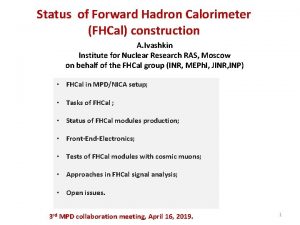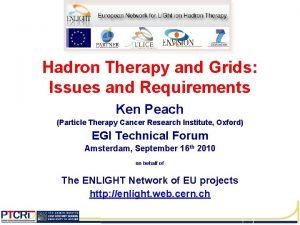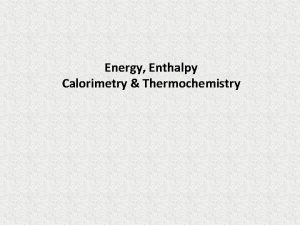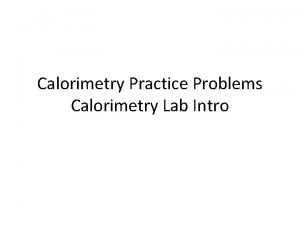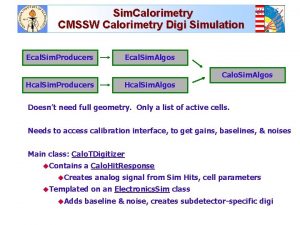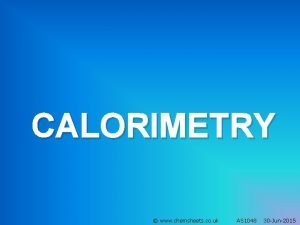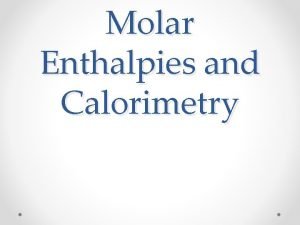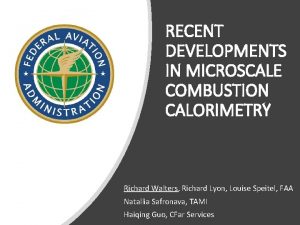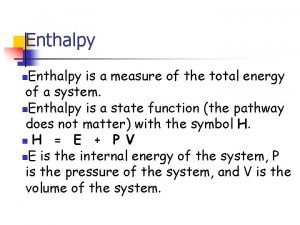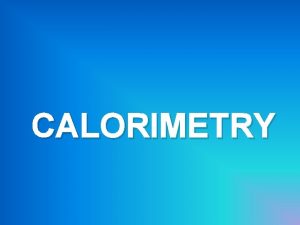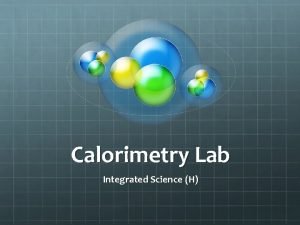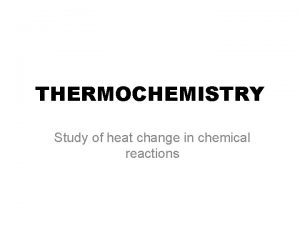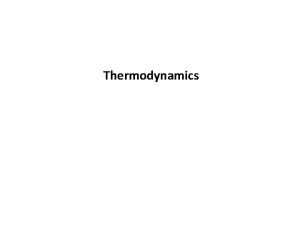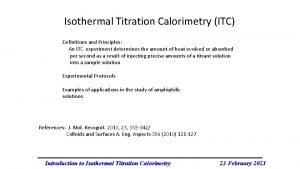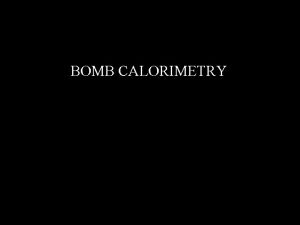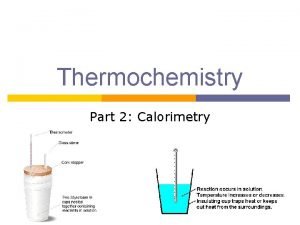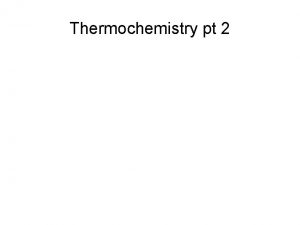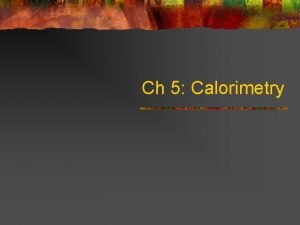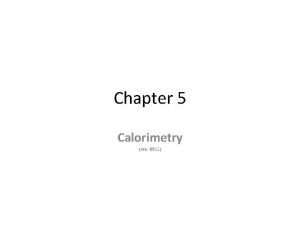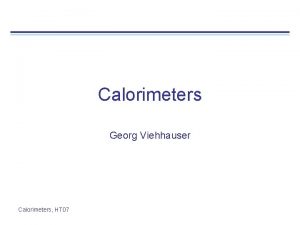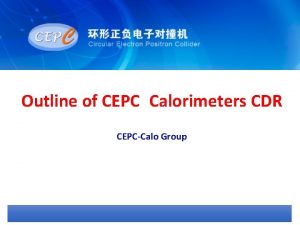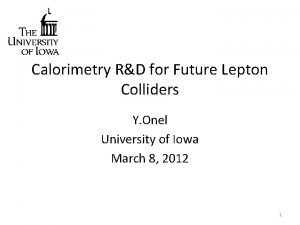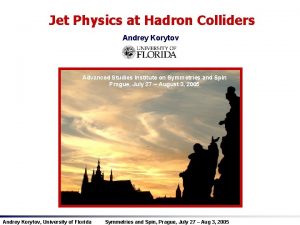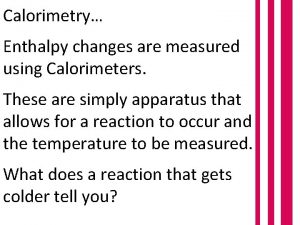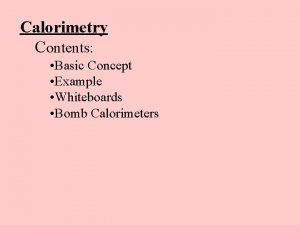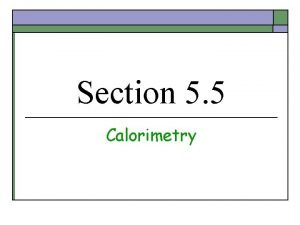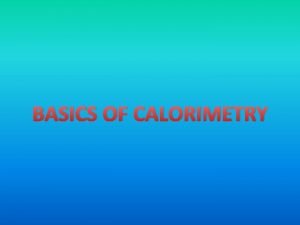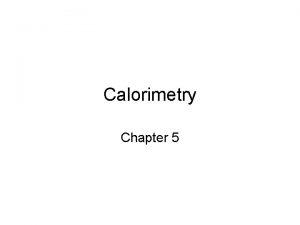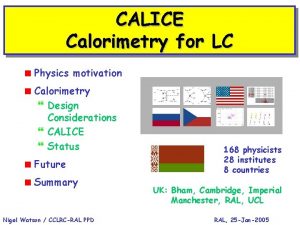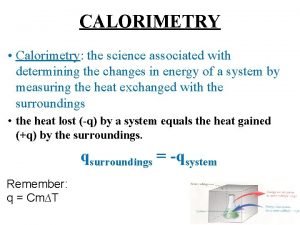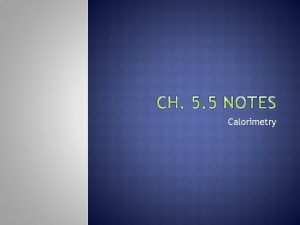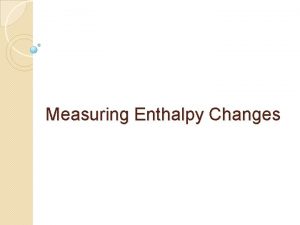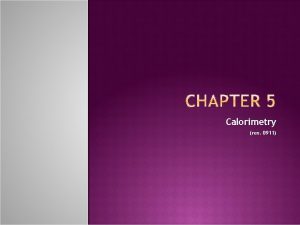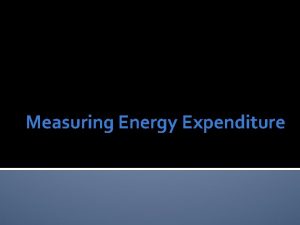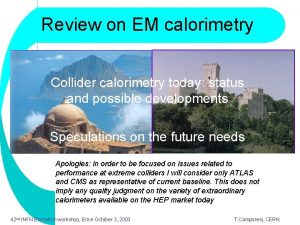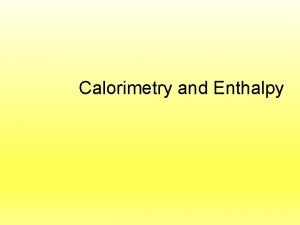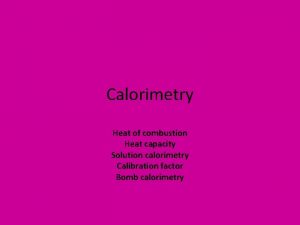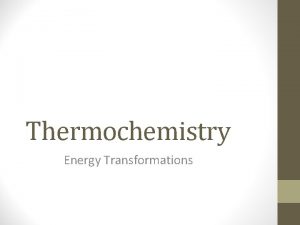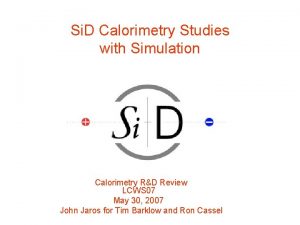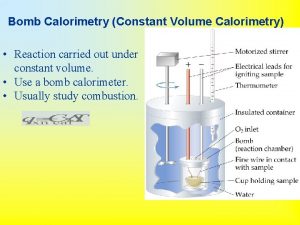Hadron Calorimeters Hadron Calorimetry For Future Hadron Colliders























































- Slides: 55

Hadron Calorimeters Hadron Calorimetry For Future Hadron Colliders Jim Freeman Fermilab J. Freeman Erice Oct 3, 2003 1

Mass Reach vs energy and L VLHC/ Eloisatron LHC Tevatron J. Freeman Erice Oct 3, 2003 2

SLHC Detector Environment LHC SLHC s L 14 Te. V 1034 100 14 Te. V 1035 1000 Bunch spacing dt 25 ns 12. 5 ns N. interactions/x-ing ~ 20 ~ 100 d. Nch/d per x-ing ~ 100 ~ 500 Tracker occupancy Pile-up noise Dose central region 1 1 1 5 ~2. 2 10 Bunch spacing reduced 2 x. Interactions/crossing increased 5 x. Pileup noise increased by 2. 2 x if crossings are time resolvable. J. Freeman Erice Oct 3, 2003 3

VLHC/ Eloisatron Detector Environment LHC VLHC s L 14 Te. V 1034 100 Bunch spacing dt 25 ns 19 ns N. interactions/x-ing ~ 20 ~ 25** d. Nch/d per x-ing ~ 100 ~ 250** Tracker occupancy Pile-up noise Dose central region 1 1 1 2. 5** 5** ** 130 m. B inelastic cross section, <Nch> ~ 10, <Et> = 1 Ge. V J. Freeman Erice Oct 3, 2003 4

ATLAS Calorimeters J. Freeman Erice Oct 3, 2003 5

ATLAS Calorimeter Tile. Cal J. Freeman Erice Oct 3, 2003 6

ATLAS LAR Hadron End. Cap J. Freeman Erice Oct 3, 2003 7

ATLAS FCAL J. Freeman Erice Oct 3, 2003 8

ATLAS FCAL J. Freeman Erice Oct 3, 2003 9

ATLAS Tilecal Fe/Scint/WLS fiber J. Freeman Erice Oct 3, 2003 4: 1 Fe: Scint 10

ATLAS TILECAL 36 modules of +/endcaps, central wheel J. Freeman Erice Oct 3, 2003 11

LHCB HCAL J. Freeman Erice Oct 3, 2003 12

LHCB Hadron Calorimeter J. Freeman Erice Oct 3, 2003 13

CMS HCALs Had Barrel: HB Had Endcaps: HE Had Forward: HF HO HB HE HF J. Freeman Erice Oct 3, 2003 14

HCAL : HE and HB HE J. Freeman Erice Oct 3, 2003 HB 15

CMS HB Calorimeter Sampling calorimeter: brass (passive) & scintillator (active) Coverage: | |<1. 3 Depth: 5. 8 lint (at =0) segmentation: f x = p resolution: ~ 120 %/ 0. 087 x 0. 087 17 layers longitudinally, Completed & assembled f x = 4 x 16 towers 20 o f J. Freeman Erice Oct 3, 2003 16

CMS HE Calorimeter Sampling calorimeter: brass (passive) & scintillator (active) Coverage: 1. 3<| |<3 Depth: 10 lint segmentation: f x = p resolution: ~ 120%/ 0. 087 x 0. 087 19 layers longitudinally 20 o Completed, assembled, HE-1 installed J. Freeman Erice Oct 3, 2003 17

Optical Design for CMS HCALs Common Technology for HB, HE, HO J. Freeman Erice Oct 3, 2003 18

HF detector 5 mm HAD (143 cm) To cope with high radiation levels (>1 Grad accumulated in 10 years) the active part is Quartz fibers: the energy measured through the Cerenkov light generated by shower particles. EM (165 cm) Iron calorimeter Covers 5 > > 3 Total of 1728 towers, i. e. 2 x 432 towers for EM and HAD x f segmentation (0. 175 x 0. 175) J. Freeman Erice Oct 3, 2003 19

Fibers in the HF absorber J. Freeman Erice Oct 3, 2003 20

HF Fiber stuffing at CERN J. Freeman Erice Oct 3, 2003 21

Issues for SLHC Radiation Damage Rate Effects Bunch ID determination J. Freeman Erice Oct 3, 2003 22

Scintillator - Dose/Damage Current operational limit ~ 5 Mrad J. Freeman Erice Oct 3, 2003 23

Radiation damage to scintillators Dose per year at SLHV ECAL HCAL Barrel doses are not a problem. For the endcaps a technology change may be needed for 2 < |y| < 3 for the CMS HCAL. J. Freeman Erice Oct 3, 2003 24

Liquid Ar Ionization At SLHC, ATLAS LAR will stop working at ~ 1. 5 Switch to liquid Xe, ? J. Freeman Erice Oct 3, 2003 25

CMS HB Pulse Shape 100 Ge. V electrons. 25 ns bins. Each histo is average pulse shape, phased +1 ns to LHC clock 12 ns difference between circled histo’s no problem with bunch ID J. Freeman Erice Oct 3, 2003 26

Calculated event time (in clock cycles) Timing using calorimeter pulse shape 2003 Test Beam CMS HE Calculated event time (vertical scale) vs actual event time. CMS HE, 100 Ge. V pions. Also works for l. Ar. DO timing resolution 4 ns/E (in Ge. V). Watch pile-up though. The faster the calorimeter, the less important pile-up will be. J. Freeman Erice Oct 3, 2003 27

What about ATLAS? CMS HE Calorimeter Atlas l. Ar EM Calorimeter 300 Ge. V p 2003 Test Beam, 1 ns bins J. Freeman Erice Oct 3, 2003 Not so different, after shaping. Bunch ID should 28 be no problem

HF Cerenkov Calorimeter Pulse Shape CMS HF Calorimeter 2003 Test Beam 25 ns Intrinsically very fast J. Freeman Erice Oct 3, 2003 29

ATLAS/CMS at SLHC Both detectors will have problems in the endcap region. ATLAS rate problems. Replace l. Ar for >1. 5 ? CMS radiation damage problems in endcap. New scintillators? Or new technology? New R&D J. Freeman Erice Oct 3, 2003 30

Profitable R&D Directions? Cerenkov calorimeters are rad-hard and fast good candidates for future colliders Quartz fiber or plate Gas cerenkov New photon detectors low cost, small, rad-hard Red-sensitive HPDs Geiger-mode photodiodes New scintillator materials rad-hard New directions: “Spacal” with liquid scintillator capillaries coupled to quartz fiber light guides? J. Freeman Erice Oct 3, 2003 31

Gas Cerenkov Lasagna J. Freeman Erice Oct 3, 2003 32

Gas Cerenkov operation The Cherenkov light is generated by shower particles that cross gaps between absorber elements. e- • Shower particles co-move with the Cherenkov light as two overlapped pancakes. The width of these pancakes is about 50 ps. • Inside surfaces must be highly reflective at grazing incidence. 3 w. hep. caltech. edu/calor 02/abstract/ Presentation/cerenkov/atramenov. ppt J. Freeman Erice Oct 3, 2003 33

Cerenkov Tile/Fiber “pmt” Quartz fiber Quartz Plate Absorber plate J. Freeman Erice Oct 3, 2003 Ti: Sapphire fiber with cladding Ti: Sapphire is a wavelength shifter and rad-hard. Index of refraction = 1. 7 Issues: light yield, purity of plate, speed of shifter. 34

Geiger-mode silicon pmt (SPMT) 40 mm 100 – 10000 SPMTs tied in parallel to same substrate. pe’s High gain, 106, low noise Issues are rad-hardness and rate ability J. Freeman Erice Oct 3, 2003 http: //www. slac. stanford. edu/pubs/icfa/fall 01/paper 3. pdf 35

New Scintillators and Shifters A 10 year long search for new organic scintillators that are rad-hard. (bulk damage to scintillator base longer wavelengths. Waveshifter chemicals that are rad-hard, fast. Inorganic wavelength shifters for cerenkov tile calorimeters. J. Freeman Erice Oct 3, 2003 36

Tracking and Energy Flow Use tracking to improve jet response J. Freeman Erice Oct 3, 2003 37

Jet Res improvement using tracking. CMS 4 T B field J. Freeman Erice Oct 3, 2003 38

Jet improvement by using tracking info “Energy Flow” Tracking from CMS, ECAL 5% stochastic, 1% constant, and HCAL 50% stochastic and 3% constant. Note that a jet has <zmax> ~ 0. 22. For charged particles < 100 Ge. V (jets < 0. 5 Te. V) use tracks to measure E. For present energy scales at the LHC use tracker energy measurement if possible. At a VLHC this will not help. (Without substantial improvements in tracking) J. Freeman Erice Oct 3, 2003 39

Energy Flow Jet Improvement J. Freeman Erice Oct 3, 2003 40

CDF Study – Photon+Jet CDF studied energy flow in photon + J events using shower max (particle id) and tracking information. A similar ~ 24% improvement was seen. J. Freeman Erice Oct 3, 2003 41

Improved Dijet Mass There is a ~ 22 % improvement in the dijet mass resolution. Implies that calorimeter resolution is not the whole story. Before Energy Flow Mean 81. 7 Ge. V, (21%) J. Freeman Erice Oct 3, 2003 Energy Flow Nr charged tracks generated/matched vs jet ET. At ET ~ 50, almost all tracks matched After Energy Flow Mean 105. 5 Ge. V, (17%) 42

New Calorimeter Issues for designing new calorimeter for VLHC/Eloisatron J. Freeman Erice Oct 3, 2003 43

Transverse Size - HCAL Shower size limits the number of resolvable “particles” in a jet, especially the dense “core” of a jet. Limits set to “energy flow” J. Freeman Erice Oct 3, 2003 44

Hadron Cascades and Energy Flow Large Fluctuations in longitudinal development of hadron showers set limits on utility of depth segmentation. fine longitudinal depth segmentation only samples intrinsic fluctuations in shower development d. E Layer # SDC Hanging File Calorimeter Data. 96 layers of scintillator, each read out with separate pmt. J. Freeman Erice Oct 3, 2003 45

Intrinsic Limitations to Containment Jet “splitting”, g -> QQ and Q -> qlv, puts intrinsic limit on required depth. Jets themselves “leak”. # Jets with energy > Missing ET J. Freeman Erice Oct 3, 2003 Jets “leak” too – 0. 1 % will lose > ½ of the energy due to splitting. 46

Calorimeter Depth Requirements CCFR Data 200 Ge. V p 10 Te. V jets Relative Resolution vs depth Conclusion no gain for calorimeters thicker than ~ 10 -12 l J. Freeman Erice Oct 3, 2003 Eleak/En as a function of depth. Hatched area is where neutrinos dominate 47

Effects of Final State Radiation No detector simulation Full detector simulation Z’s at the LHC in “CMS” detector J. Freeman Erice Oct 3, 2003 48

LHC – CMS Study of FSR MJJ/Mo plots for dijets in CMS with and without FSR. The dominant effect of FSR is clear. The d(M/Mo)/(M/Mo) rms rises from ~ 11% to ~ 19%, the distribution shifts to smaller M/Mo, and a radiative low mass tail becomes evident. J. Freeman Erice Oct 3, 2003 d. M/Mo 49

Hadron Collider- Dijet d. M/M A series of Monte Carlo studies were done in order to identify the elements contributing to the mass error. Events are low PT, Z -> JJ. d. M/M ~ 13% without FSR is the biggest effect. The underlying event is the second largest error (if cone R ~ 0. 7). Calorimeter resolution is a minor effect. J. Freeman Erice Oct 3, 2003 50

Effects of Pileup Events 120 Ge. V Z’ 1033 1035 1034 J. Freeman Erice Oct 3, 2003 Forward tag jets, ET~ 40 Ge. V 51

Pile-up Missing Et Study done for CMS. Three major sources of detector induced missing ET – incomplete angular coverage, B field “sweeping” to small angles and calorimetric energy resolution. Clearly need radiation hard calorimetry to go to smaller angles – as C. M. energy increases particularly. Presently dose < 1 Grad at | | = 5. At SLHC, pileup events create a background of ~ 5 Ge. V * sqrt(62) = 40 Ge. V ET-miss / crossing. Fatal for W’s, no problem for SUSY. <ET-miss>/minbias event vs eta coverage J. Freeman Erice Oct 3, 2003 Contributions to ET-miss for minbias events 52

Intrinsic Limitations Transverse size set by shower extent, either Xo or -> limit to tower size. Longitudinal depth set by containment to ~ 10 . Limit on depth set by jet leakage. Speed needs to be fast enough to identify bunch crossing (25 ns/LHC ; 12. 5 ns/SLHC; 18 ns VLHC) Jet resolution limited by FSR at LHC, not calorimeter energy resolution. J. Freeman Erice Oct 3, 2003 53

New Calorimeter Design If you are building a new calorimeter for SLHC/VLHC Speed is very important (12. 5 ns bunch spacing) Radiation resistance critical Any new calorimeter will be designed with Energy Flow in mind. To take good advantage of Energy Flow, ~5 X 5 cm HCAL tower size Limited longitudinal segmentation 10 -12 l thick Energy resolution not too important. Can see two variants: ATLAS-like liquid ionization CMS-like optical J. Freeman Erice Oct 3, 2003 54

Summary ATLAS and CMS Hadron calorimeters will need upgrade for SLHC New algorithms (Energy Flow) improve jet resolution. Ultimate limits of method include finite shower sizes. Unfortunately utility decreases for increasing jet energies. Final State radiation remains major limitation to di-jet mass resolution. Address this with improved analysis methods? Studies of higher mass states will require higher luminosity which will put in premium on radiation resistance. Colliders with increased luminosity and energy will require detector development: Cerenkov calorimeters Replacement fluids for LAr in forward regions Advanced photodetectors Improved materials (scintillators or quartz fiber) Possible new directions (gas-cerenkov calorimeter) J. Freeman Erice Oct 3, 2003 55
 Exercise future continuous and future perfect
Exercise future continuous and future perfect Future perfect e future continuous
Future perfect e future continuous Hadron
Hadron Hadron calorimeter
Hadron calorimeter Hadron
Hadron Hadron collider
Hadron collider Hadron collider
Hadron collider Hess law constant heat summation
Hess law constant heat summation Calorimetry practice problems
Calorimetry practice problems Cmmsw adalah
Cmmsw adalah Bomb calorimetry equation
Bomb calorimetry equation Q=mc∆t
Q=mc∆t Calorimetry lesson
Calorimetry lesson Microscale combustion calorimetry
Microscale combustion calorimetry Qlost = qgained
Qlost = qgained Q mc ∆ t
Q mc ∆ t Food calorimetry lab
Food calorimetry lab Calorimetry equation
Calorimetry equation Calorimeter formula
Calorimeter formula Isothermal titration calorimetry principle
Isothermal titration calorimetry principle Bomb calorimetry
Bomb calorimetry Bomb calorimeter
Bomb calorimeter Calorimetry
Calorimetry Future continuous tense vs future simple
Future continuous tense vs future simple Budoucí čas will
Budoucí čas will Plan in present progressive
Plan in present progressive Future perfect future continuous exercises
Future perfect future continuous exercises 1 2 3 kondicional u engleskom jeziku
1 2 3 kondicional u engleskom jeziku Tense chart
Tense chart Future nurse programme
Future nurse programme Perfect future
Perfect future Present continuous future
Present continuous future Future plans and finished future actions
Future plans and finished future actions Inköpsprocessen steg för steg
Inköpsprocessen steg för steg Expektans eller exspektans
Expektans eller exspektans Urban torhamn
Urban torhamn Strategi för svensk viltförvaltning
Strategi för svensk viltförvaltning Anatomi organ reproduksi
Anatomi organ reproduksi Vad är verksamhetsanalys
Vad är verksamhetsanalys Typiska drag för en novell
Typiska drag för en novell Formula varians
Formula varians Tack för att ni har lyssnat
Tack för att ni har lyssnat Läkarutlåtande för livränta
Läkarutlåtande för livränta Treserva lathund
Treserva lathund Påbyggnader för flakfordon
Påbyggnader för flakfordon Tack för att ni lyssnade
Tack för att ni lyssnade En lathund för arbete med kontinuitetshantering
En lathund för arbete med kontinuitetshantering Egg för emanuel
Egg för emanuel Atmosfr
Atmosfr Rutin för avvikelsehantering
Rutin för avvikelsehantering Mitos steg
Mitos steg Programskede byggprocessen
Programskede byggprocessen Myndigheten för delaktighet
Myndigheten för delaktighet Presentera för publik crossboss
Presentera för publik crossboss Hur skriver man en tes
Hur skriver man en tes Kung dog 1611
Kung dog 1611



